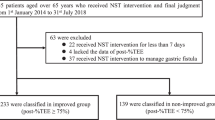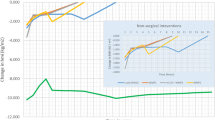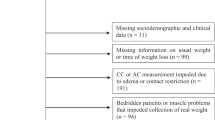Abstract
Background/objectives:
This study estimates the economic outcomes of a nutrition intervention to at-risk patients compared with standard care in the prevention of pressure ulcer.
Subjects/methods:
Statistical models were developed to predict ‘cases of pressure ulcer avoided’, ‘number of bed days gained’ and ‘change to economic costs’ in public hospitals in 2002–2003 in Queensland, Australia. Input parameters were specified and appropriate probability distributions fitted for: number of discharges per annum; incidence rate for pressure ulcer; independent effect of pressure ulcer on length of stay; cost of a bed day; change in risk in developing a pressure ulcer associated with nutrition support; annual cost of the provision of a nutrition support intervention for at-risk patients. A total of 1000 random re-samples were made and the results expressed as output probability distributions.
Results:
The model predicts a mean 2896 (s.d. 632) cases of pressure ulcer avoided; 12 397 (s.d. 4491) bed days released and corresponding mean economic cost saving of euros 2 869 526 (s.d. 2 078 715) with a nutrition support intervention, compared with standard care.
Conclusion:
Nutrition intervention is predicted to be a cost-effective approach in the prevention of pressure ulcer in at-risk patients.
This is a preview of subscription content, access via your institution
Access options
Subscribe to this journal
Receive 12 print issues and online access
$259.00 per year
only $21.58 per issue
Buy this article
- Purchase on Springer Link
- Instant access to full article PDF
Prices may be subject to local taxes which are calculated during checkout



Similar content being viewed by others
References
Whittington KT, Briones R . National prevalence and incidence study: 6 year sequential acute care data. Adv Skin Wound Care 2004; 17: 490–494.
Vanderwee K, Clark M, Dealey C, Gunningberg L, Defloor T . Pressure ulcer prevalence in Europe: a pilot study. J Eval Clin Pract 2007; 13: 227–235.
Graves N, Birrell FA, Whitby M . Effect of pressure ulcers on length of hospital stay. Infect Control Hosp Epidemiol 2005; 26: 293–297.
Bennett G, Dealey C, Posnett J . The cost of pressure ulcers in the UK. Age Ageing 2004; 33: 230–235.
Thomas DR . Prevention and treatment of pressure ulcers. J Am Med Dir Assoc 2006; 7: 46–59.
Stratton R, Green CJ, Elia M . Disease-Related Malnutrition: An Evidence-Based Approach to Treatment. CABI Publishing: Wallingford, UK, 2003.
Graves N, Birrell FA, Whitby M . Modelling the economic losses from pressure ulcers among hospitalized patients in Australia. Wound Repair Regen 2005; 13: 462–467.
Banks MD, Bauer J, Graves N, Ash S . Malnutrition and pressure ulcer risk in Australian Hospitals. Nutrition 2010; 26: 896–901.
Banks M, Graves N, Bauer J, Ash S . The costs arising from pressure ulcers attributable to malnutrition. Clin Nutr 2010; 29: 180–186.
Delmi M, Rapin CH, Bengoa JM, Delmas PD, Vasey H, Bonjour JP . Dietary supplementation in elderly patients with fractured neck of femur. Lancet 1990; 335: 1013–1016.
Ek AC, Unosson M, Larsson J, von Schenck H, Bjurulf P . The development and healing of pressure sores related to nutritional state. Clin Nutr 1991; 10: 245–250.
Hartgrink HH, Wille J, Konig P, Hermans J, Breslau PJ . Pressure sores and tube feeding in patients with fracture of the hip: a randomized clinical trial. Clin Nutr 1998; 17: 287–292.
Bourdel-Marchasson I, Barateau MRV, Dequae-Merchadou L, Salles-Montaudon N, Emeriau JP, Manciet G et al. A multi-center trial of the effects of oral nutritional supplementation in critically ill older patients. Nutrition 2000; 16: 1–5.
Houwing RH, Rozendaal M, Wouters-Wesseling W, Beulens JW, Buskens E, Haalboom JA . Randomised, double-blind assessment of the effect of nutritional supplementation on the prevention of pressure ulcers in hip-fracture patients. Clin Nutr 2003; 22: 401–405.
Stratton R, Ek AC, Moore MEZ, Rigby P, Wolfe R, Elia M . Enteral nutritional support in prevention and treatment of pressure ulcers: a systematic review and meta-analysis. Ageing Res Rev 2005; 4: 422–450.
Hastings NAJ, Peacock JB . Statistical Distributions. A Handbook for Students and Practitioners. Butterworths: London, 1975.
AIHW. Australian Hospital Statistics 2002/2003. Australian Institute of Health and Welfare: Canberra, Australia, 2004.
Iglesias C, Nixon J, Cranny G, Nelson EA, Hawkins K, Phillips A et al. PRESSURE Trial Group. Pressure relieving support surfaces (PRESSURE) trial: cost effectiveness analysis. BMJ 2006; 332: 1416.
Fleurence RL . Cost effectiveness of pressure-relieving devices for the prevention and tratment of pressure ulcers. Int J Technol Assess Health Care 2005; 21: 334–341.
Trueman P, Whitehead S . The economics of pressure relieving surfaces: an illustrative case study of the impact of high-specification surfaces on hospital finances. Int Wound J 2010; 7: 48–54.
Joansen N, Kondrup J, Plum LM, Bak L, Norregaard P, Bunch E et al. Effect of nutritional support on clinical outcome in patients at nutritional risk. Clin Nutr 2004; 23: 539–550.
Tucker HN, Miguel SG . Cost containment through Nutrition Intervention. Nutr Rev 1996; 54: 111–121.
Arnaud-Battandier F, Malvy D, Jeandel C, Schmitt C, Aussage P, Beaufrere B et al. Use of oral supplements in malnourished elderly patients living in the community: a pharmaco-economic study. Clin Nutr 2004; 23: 1096–1103.
Pritchard C, Duffy S, Edington J, Pang F . Enteral nutrition and oral nutrition supplements: a review of the economics literature. JPEN 2006; 30: 52–59.
Acknowledgements
This research was supported by a grant from the Royal Brisbane & Women’s Hospital Research Foundation.
Author information
Authors and Affiliations
Corresponding author
Ethics declarations
Competing interests
The authors declare no conflict of interest.
Additional information
Supplementary Information accompanies the paper on European Journal of Clinical Nutrition website
Supplementary information
Rights and permissions
About this article
Cite this article
Banks, M., Graves, N., Bauer, J. et al. Cost effectiveness of nutrition support in the prevention of pressure ulcer in hospitals. Eur J Clin Nutr 67, 42–46 (2013). https://doi.org/10.1038/ejcn.2012.140
Received:
Revised:
Accepted:
Published:
Issue Date:
DOI: https://doi.org/10.1038/ejcn.2012.140
Keywords
This article is cited by
-
Predictors of pressure ulcer incidence following traumatic spinal cord injury: a secondary analysis of a prospective longitudinal study
Spinal Cord (2018)
-
Cost-Effectiveness and Value of Information Analysis of Nutritional Support for Preventing Pressure Ulcers in High-risk Patients: Implement Now, Research Later
Applied Health Economics and Health Policy (2015)
-
Malnutrition and Neurodegenerative Diseases
Current Nutrition Reports (2014)



